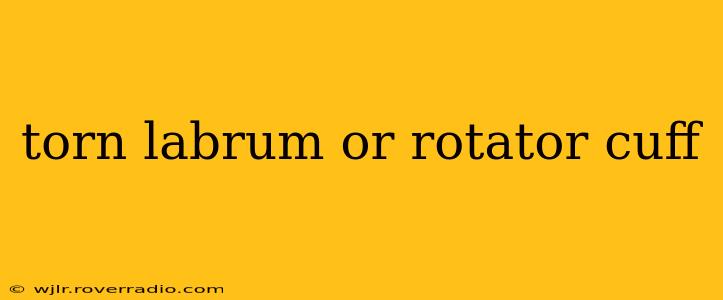Shoulder pain is a common complaint, often stemming from injuries to the labrum or rotator cuff. While both structures are crucial for shoulder stability and function, a torn labrum and a rotator cuff tear present with different symptoms and require distinct treatment approaches. This article will delve into the differences between these two conditions, helping you better understand the potential causes, symptoms, diagnosis, and treatment options.
What is a Torn Labrum?
The labrum is a ring of cartilage that surrounds the glenoid, the socket of the shoulder joint. It acts as a cushion, deepening the socket and providing stability to the shoulder. A torn labrum occurs when this cartilage is damaged, often due to a sudden injury like a fall or a forceful impact. It can also develop gradually due to repetitive overhead movements or chronic instability.
Types of Labral Tears:
Labral tears can be categorized in several ways, including the location and the type of tear. Some common types include:
- SLAP (Superior Labrum Anterior to Posterior) Lesion: This involves a tear in the upper part of the labrum, often affecting the biceps tendon attachment.
- Bankart Lesion: This type of tear occurs in the anterior (front) part of the labrum, often associated with shoulder dislocation.
What is a Rotator Cuff Tear?
The rotator cuff is a group of four muscles and their tendons that surround the shoulder joint. These muscles control the shoulder's range of motion and stability. A rotator cuff tear involves damage to one or more of these tendons, resulting in pain, weakness, and limited mobility.
Causes of Rotator Cuff Tears:
Rotator cuff tears can result from acute injuries, such as a fall or a direct blow to the shoulder, or they can develop gradually due to overuse, aging, or repetitive motions.
What are the Symptoms of a Torn Labrum vs. Rotator Cuff Tear?
While both injuries can cause shoulder pain, the symptoms often differ:
Torn Labrum:
- Clicking or popping sensation: This is a hallmark symptom of a labral tear, often felt during movement.
- Shoulder instability: Feelings of the shoulder "giving way" or dislocating are common.
- Pain with overhead activities: Lifting or reaching overhead can aggravate the pain.
- Deep, aching pain: The pain is often localized deep within the shoulder joint.
Rotator Cuff Tear:
- Sharp, localized pain: Pain is often felt in the outer shoulder or upper arm.
- Weakness: Difficulty lifting or rotating the arm.
- Limited range of motion: Pain and stiffness restrict movement.
- Night pain: Pain may worsen at night, especially when lying on the affected side.
How are Torn Labrums and Rotator Cuff Tears Diagnosed?
Diagnosis typically involves a physical exam and imaging studies:
- Physical Exam: Your doctor will assess your range of motion, strength, and tenderness. Specific tests can help identify labral or rotator cuff involvement.
- X-rays: These can rule out fractures or other bone abnormalities, but they may not always show labral or rotator cuff tears.
- MRI: Magnetic resonance imaging provides detailed images of the soft tissues, allowing for accurate visualization of labral tears and rotator cuff tears.
- Arthrogram: This involves injecting contrast dye into the shoulder joint to enhance the visualization of labral tears on an MRI or X-ray.
What is the Treatment for a Torn Labrum or Rotator Cuff Tear?
Treatment options depend on the severity of the tear and your individual circumstances:
Non-surgical Treatment:
- Rest and ice: Resting the shoulder and applying ice can help reduce pain and inflammation.
- Physical therapy: Strengthening and stretching exercises can improve function and stability.
- Medication: Pain relievers and anti-inflammatory drugs can help manage pain.
Surgical Treatment:
- Arthroscopic surgery: This minimally invasive procedure is often used to repair labral tears and some rotator cuff tears.
- Open surgery: For larger or more complex tears, open surgery may be necessary.
Can a Torn Labrum Heal on Its Own?
Small, asymptomatic labral tears may heal on their own without intervention. However, larger or symptomatic tears often require treatment to restore function and stability.
Can a Rotator Cuff Tear Heal Without Surgery?
Smaller, partial-thickness rotator cuff tears may heal with conservative treatment, including rest, physical therapy, and medication. Larger or full-thickness tears often require surgical repair.
How Long Does it Take to Recover from a Torn Labrum or Rotator Cuff Surgery?
Recovery time varies depending on the type and extent of the injury, as well as individual factors. Generally, it can take several months to fully recover from surgery, with a gradual return to activities.
What are the Long-Term Outcomes of Torn Labrum and Rotator Cuff Repairs?
With appropriate treatment, most individuals experience significant improvement in shoulder function and pain relief. However, the long-term outcome depends on factors such as the severity of the injury, adherence to the rehabilitation program, and the individual's overall health. Follow-up with your physician and physical therapist is essential for optimal recovery.
This information is intended for educational purposes only and should not be considered medical advice. Always consult with a healthcare professional for diagnosis and treatment of any medical condition.
